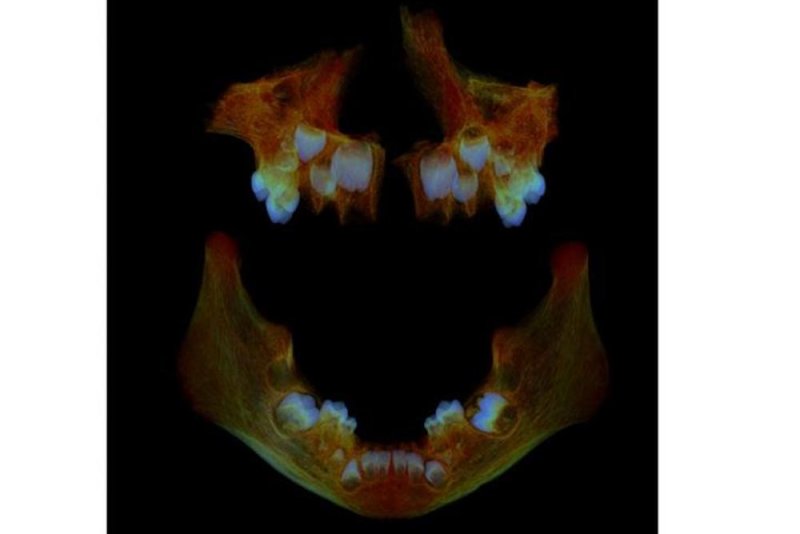A CT scan shows the jaws of 5-year-old Anglo Saxon child. Photo by University of Bradford
Sept. 6 (UPI) -- Scientists have developed a new method for measuring the health and development of moms and babies long after they're gone.
According to new research, the measure of dentine in the milk teeth, or baby teeth, can serve as a reliable indicator of health among early human populations.
For the study, scientists analyzed the baby teeth of more than 1,000 Anglo Saxon children living among the Raunds Furnells settlements. Archaeologists believe the population was under nourished.
By comparing the teeth of children who survived the first 1,000 days from conception with those who did not, scientists were able to identify biomarkers that might predict positive and negative health outcomes.
Researchers have traditionally relied on bones to study the health of earlier human populations, but stress can retard bone growth, limiting the available biological evidence.
Dentine continues to grow, even during times of environmental and biological stress. As it grows, dentine concentrates nitrogen values, proving a more comprehensive record of the diet, health and development of both mother and child.
"This is the first time that we have been able to measure with confidence the in utero nitrogen values of dentine," Julia Beaumont, researcher at the University of Bradford's School of Archaeological and Forensic Sciences, said in a news release. "We find that when bone and teeth form at the same time, bone doesn't record high nitrogen values that occur during stress. Our hypothesis is that bone isn't growing but teeth are."
Bones will continue to provide important insights into the health of earlier human populations, but the latest findings, published this week in the American Journal of Physical Anthropology, suggest the analysis of teeth is essential to an accurate record of health -- especially during lean times.
"So archaeology can't rely on the evidence from bones alone because bone is not forming and recording during high stress and we can't be sure, for example, of the age of a skeleton," Beaumont said. "Teeth are more reliable as they continue to grow even when a child is starving."
By comparing relationships between milk teeth biomarkers and health outcomes observed among both Anglo Saxon children and modern children, scientists could gain new insights into modern health risks.
"There is a growing consensus that factors such as low birthweight have a significant impact on our likelihood of developing conditions such as heart disease, diabetes and obesity and that the first 1,000 days from conception onwards set our template," Beaumont said. "By analyzing the milk teeth of modern children in the same way as the Anglo Saxon skeletons, we can measure the same values and see the risk factors they are likely to face in later life, enabling measures to be taken to mitigate such risks."















